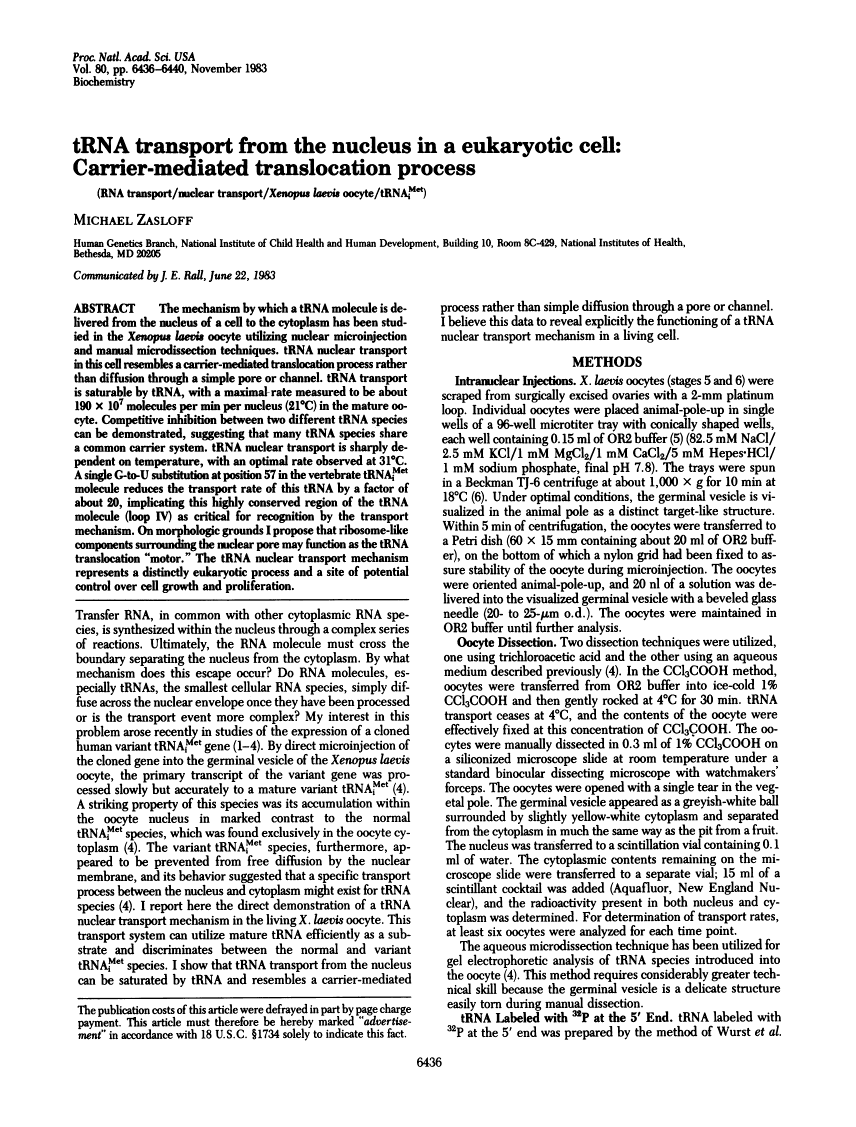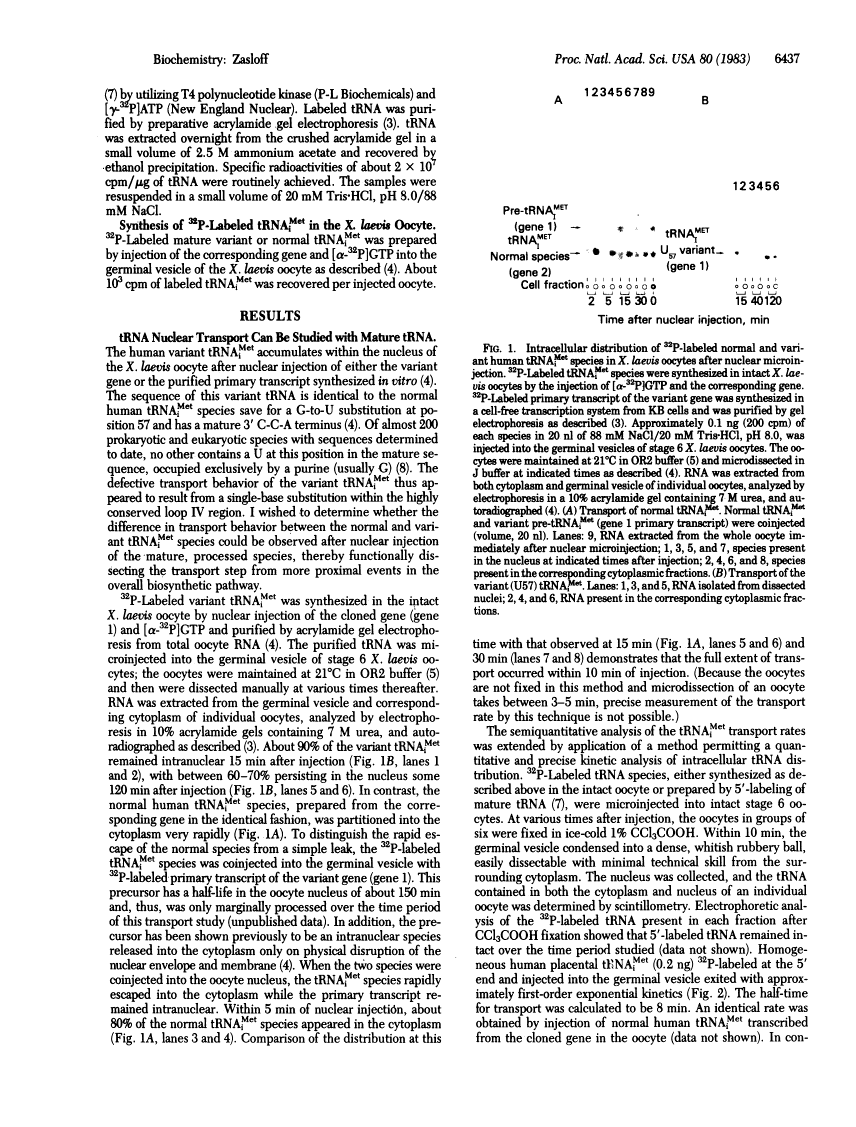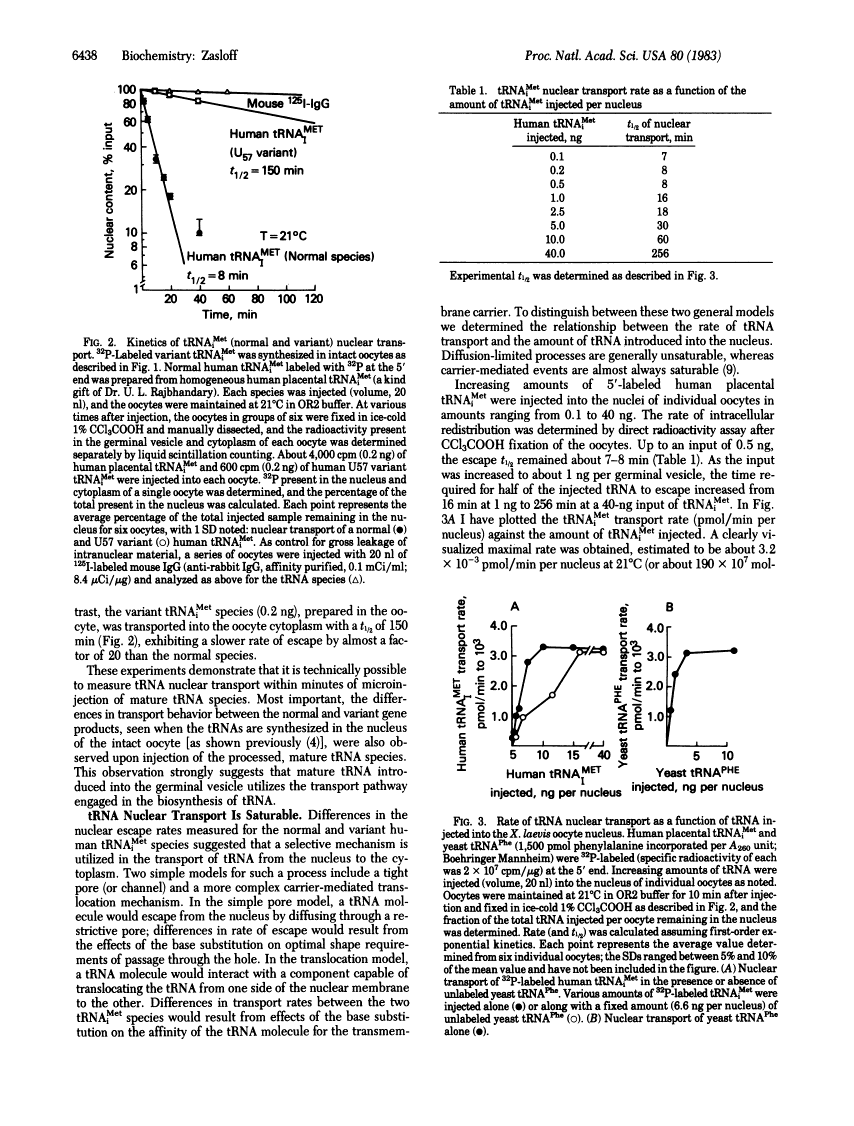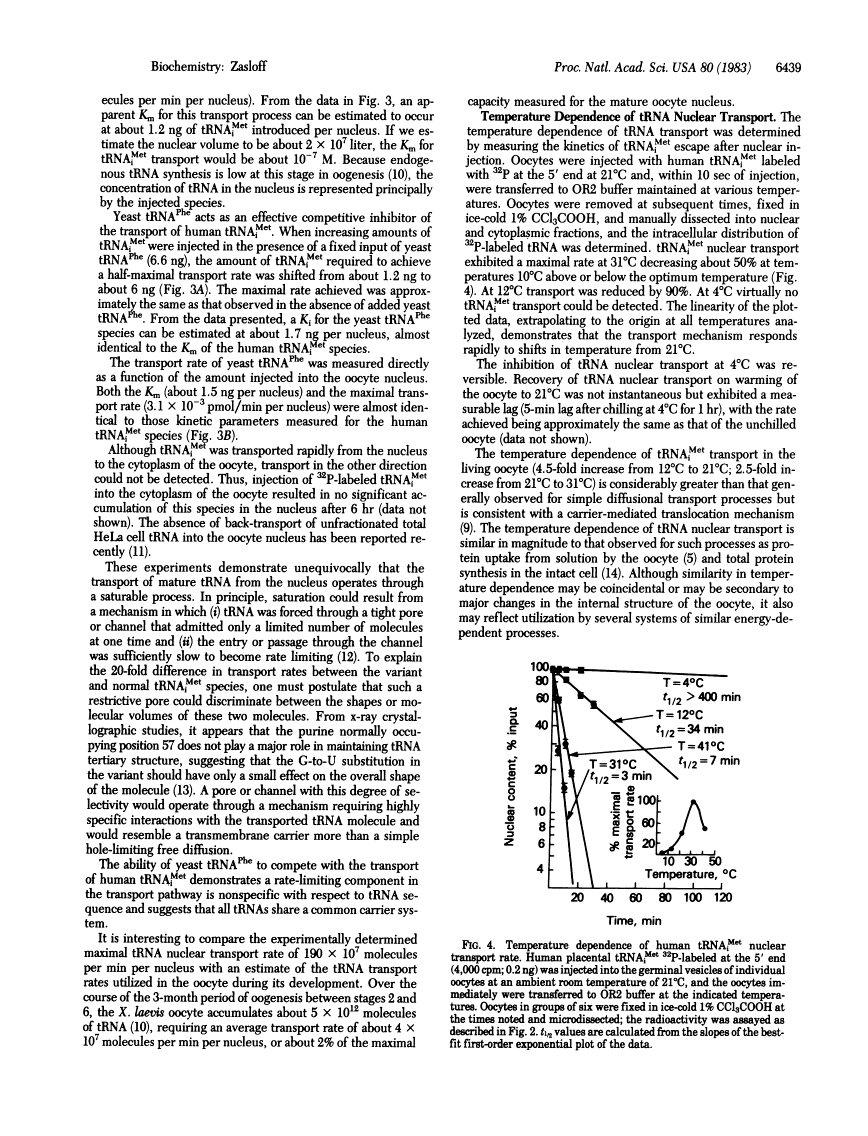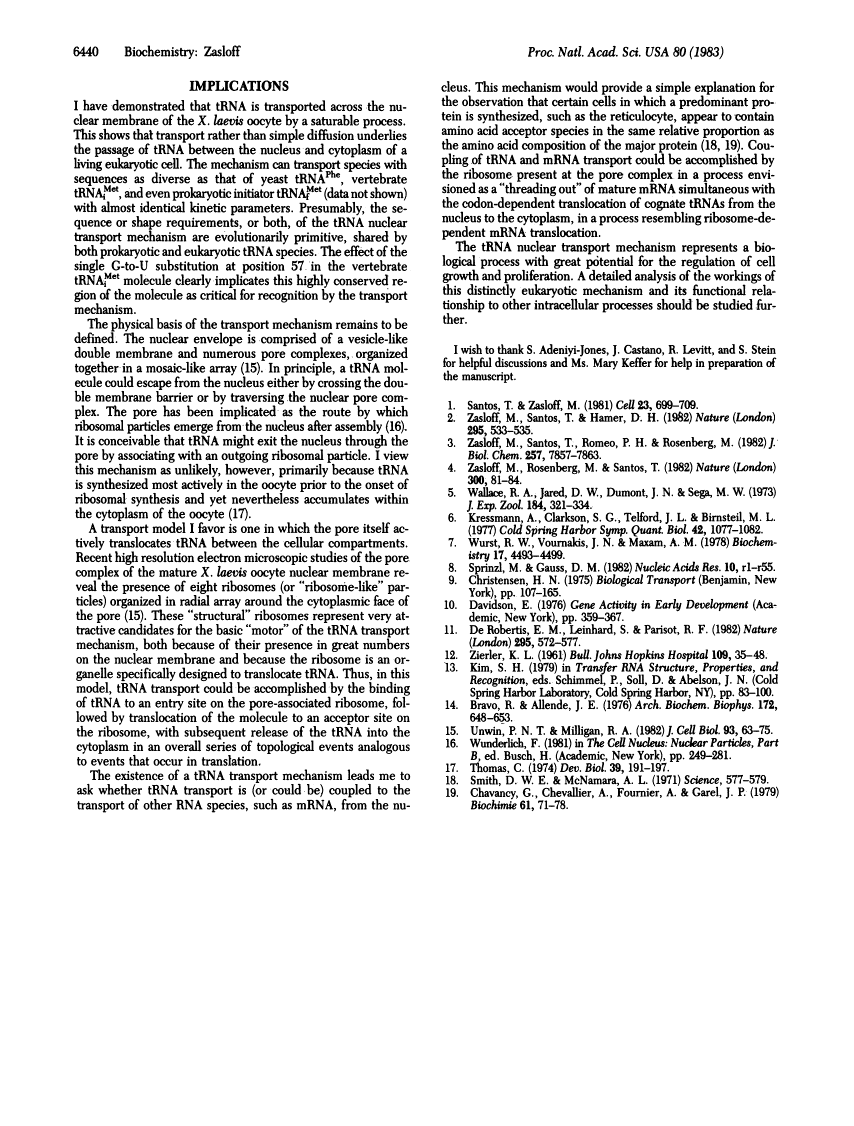Abstract
Free full text

tRNA transport from the nucleus in a eukaryotic cell: carrier-mediated translocation process.
Abstract
The mechanism by which a tRNA molecule is delivered from the nucleus of a cell to the cytoplasm has been studied in the Xenopus laevis oocyte utilizing nuclear microinjection and manual microdissection techniques. tRNA nuclear transport in this cell resembles a carrier-mediated translocation process rather than diffusion through a simple pore or channel. tRNA transport is saturable by tRNA, with a maximal rate measured to be about 190 X 10(7) molecules per min per nucleus (21 degrees C) in the mature oocyte. Competitive inhibition between two different tRNA species can be demonstrated, suggesting that many tRNA species share a common carrier system. tRNA nuclear transport is sharply dependent on temperature, with an optimal rate observed at 31 degrees C. A single G-to-U substitution at position 57 in the vertebrate tRNAMeti molecule reduces the transport rate of this tRNA by a factor of about 20, implicating this highly conserved region of the tRNA molecule (loop IV) as critical for recognition by the transport mechanism. On morphologic grounds I propose that ribosome-like components surrounding the nuclear pore may function as the tRNA translocation "motor." The tRNA nuclear transport mechanism represents a distinctly eukaryotic process and a site of potential control over cell growth and proliferation.
Full text
Full text is available as a scanned copy of the original print version. Get a printable copy (PDF file) of the complete article (1.1M), or click on a page image below to browse page by page. Links to PubMed are also available for Selected References.
Images in this article
Click on the image to see a larger version.
Selected References
These references are in PubMed. This may not be the complete list of references from this article.
- Santos T, Zasloff M. Comparative analysis of human chromosomal segments bearing nonallelic dispersed tRNAimet genes. Cell. 1981 Mar;23(3):699–709. [Abstract] [Google Scholar]
- Zasloff M, Santos T, Hamer DH. TRNA precursor transcribed from a mutant human gene inserted into a SV40 vector is processed incorrectly. Nature. 1982 Feb 11;295(5849):533–535. [Abstract] [Google Scholar]
- Zasloff M, Santos T, Romeo P, Rosenberg M. Transcription and precursor processing of normal and mutant human tRNAiMet genes in a homologous cell-free system. J Biol Chem. 1982 Jul 10;257(13):7857–7863. [Abstract] [Google Scholar]
- Zasloff M, Rosenberg M, Santos T. Impaired nuclear transport of a human variant tRNAiMet. Nature. 1982 Nov 4;300(5887):81–84. [Abstract] [Google Scholar]
- Wallace RA, Jared DW, Dumont JN, Sega MW. Protein incorporation by isolated amphibian oocytes. 3. Optimum incubation conditions. J Exp Zool. 1973 Jun;184(3):321–333. [Abstract] [Google Scholar]
- Kressmann A, Clarkson SG, Telford JL, Birnstiel ML. Transcription of xenopus tDNAmet1 and sea urchin histone DNA injected into the Xenopus oocyte nucleus. Cold Spring Harb Symp Quant Biol. 1978;42(Pt 2):1077–1082. [Abstract] [Google Scholar]
- Wurst RM, Vournakis JN, Maxam AM. Structure mapping of 5'-32P-labeled RNA with S1 nuclease. Biochemistry. 1978 Oct 17;17(21):4493–4499. [Abstract] [Google Scholar]
- Sprinzl M, Gauss DH. Compilation of tRNA sequences. Nucleic Acids Res. 1982 Jan 22;10(2):r1–55. [Europe PMC free article] [Abstract] [Google Scholar]
- De Robertis EM, Lienhard S, Parisot RF. Intracellular transport of microinjected 5S and small nuclear RNAs. Nature. 1982 Feb 18;295(5850):572–577. [Abstract] [Google Scholar]
- ZIERLER KL. A model of a poorly-permeable membrane as an alternative to the carrier hypothesis of cell membrane penetration. Bull Johns Hopkins Hosp. 1961 Jul;109:35–48. [Abstract] [Google Scholar]
- Bravo R, Allende JE. Conditions affecting protein synthesis in amphibian oocytes. Arch Biochem Biophys. 1976 Feb;172(2):648–653. [Abstract] [Google Scholar]
- Unwin PN, Milligan RA. A large particle associated with the perimeter of the nuclear pore complex. J Cell Biol. 1982 Apr;93(1):63–75. [Europe PMC free article] [Abstract] [Google Scholar]
- Thomas C. RNA metabolism in previtellogenic oocytes of Xenopus laevis. Dev Biol. 1974 Aug;39(2):191–197. [Abstract] [Google Scholar]
- Chavancy G, Chevallier A, Fournier A, Garel JP. Adaptation of iso-tRNA concentration to mRNA codon frequency in the eukaryote cell. Biochimie. 1979;61(1):71–78. [Abstract] [Google Scholar]
Associated Data
Articles from Proceedings of the National Academy of Sciences of the United States of America are provided here courtesy of National Academy of Sciences
Full text links
Read article at publisher's site: https://doi.org/10.1073/pnas.80.21.6436
Read article for free, from open access legal sources, via Unpaywall:
https://europepmc.org/articles/pmc390128?pdf=render
Citations & impact
Impact metrics
Citations of article over time
Article citations
tRNA Modifications and Dysregulation: Implications for Brain Diseases.
Brain Sci, 14(7):633, 25 Jun 2024
Cited by: 0 articles | PMID: 39061374 | PMCID: PMC11274612
Review Free full text in Europe PMC
Transfer RNAs: diversity in form and function.
RNA Biol, 18(3):316-339, 09 Sep 2020
Cited by: 40 articles | PMID: 32900285 | PMCID: PMC7954030
Review Free full text in Europe PMC
Sharing the load: Mex67-Mtr2 cofunctions with Los1 in primary tRNA nuclear export.
Genes Dev, 31(21):2186-2198, 01 Nov 2017
Cited by: 28 articles | PMID: 29212662 | PMCID: PMC5749166
tRNA dynamics between the nucleus, cytoplasm and mitochondrial surface: Location, location, location.
Biochim Biophys Acta Gene Regul Mech, 1861(4):373-386, 28 Nov 2017
Cited by: 45 articles | PMID: 29191733 | PMCID: PMC5882565
Review Free full text in Europe PMC
RNA Export through the NPC in Eukaryotes.
Genes (Basel), 6(1):124-149, 20 Mar 2015
Cited by: 72 articles | PMID: 25802992 | PMCID: PMC4377836
Review Free full text in Europe PMC
Go to all (103) article citations
Data
Similar Articles
To arrive at the top five similar articles we use a word-weighted algorithm to compare words from the Title and Abstract of each citation.
